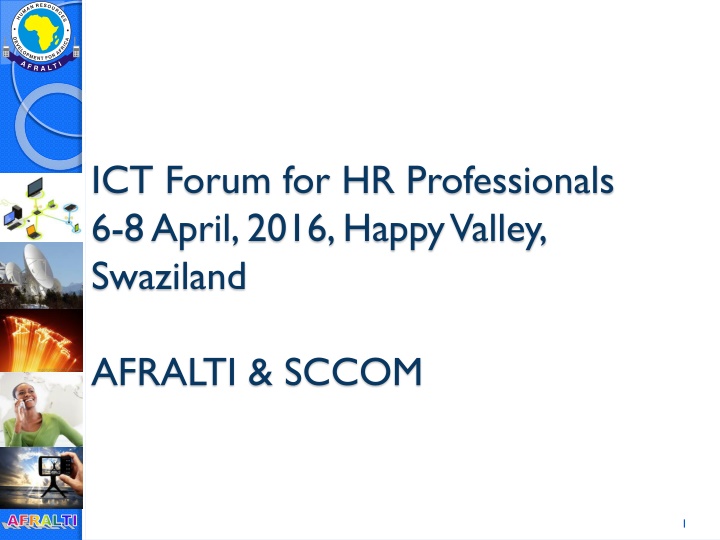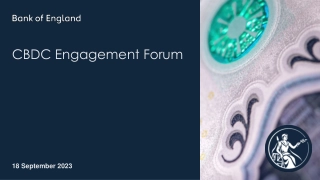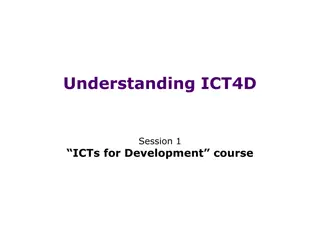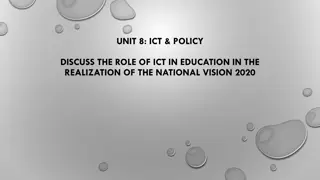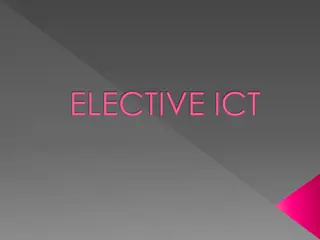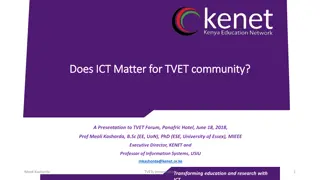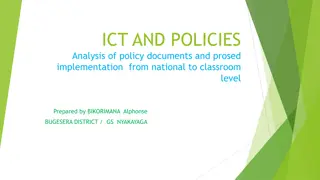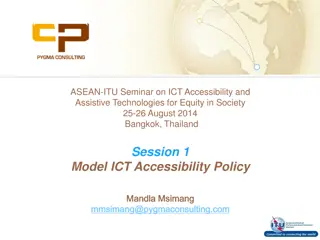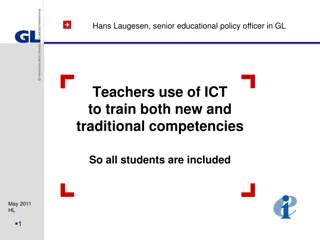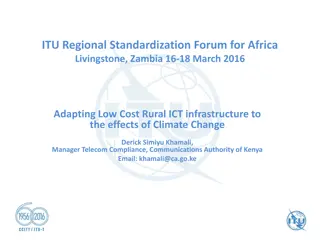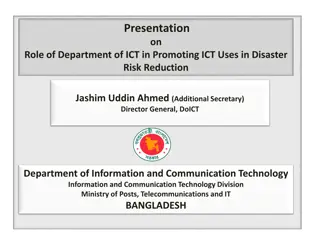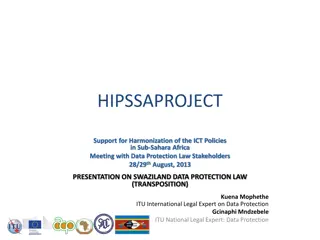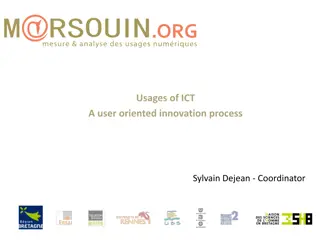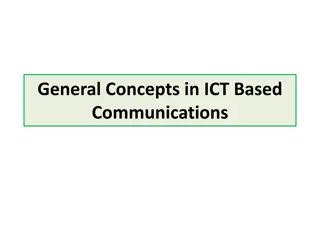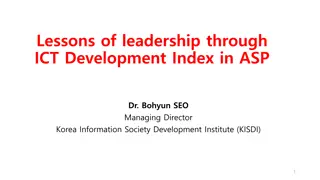ICT Forum for HR Professionals in Swaziland, 6-8 April 2016
Delve into the latest trends and insights in HR technology at the ICT Forum for HR Professionals held in Happy Valley, Swaziland. Explore topics such as securing the e-Workforce, technology impact at the workplace, cyber environment, information security, and more. Discover the positive impacts of technology on the workplace and learn about the significant role of the Internet in shaping our digital world. Stay updated on industry news and innovative uses of technology in HR practices.
Download Presentation

Please find below an Image/Link to download the presentation.
The content on the website is provided AS IS for your information and personal use only. It may not be sold, licensed, or shared on other websites without obtaining consent from the author.If you encounter any issues during the download, it is possible that the publisher has removed the file from their server.
You are allowed to download the files provided on this website for personal or commercial use, subject to the condition that they are used lawfully. All files are the property of their respective owners.
The content on the website is provided AS IS for your information and personal use only. It may not be sold, licensed, or shared on other websites without obtaining consent from the author.
E N D
Presentation Transcript
ICT Forum for HR Professionals 6-8 April, 2016, Happy Valley, Swaziland AFRALTI & SCCOM AFRALTI 1
Securing the e-Workforce Mr. Stephen Gachogu Information Systems Professional AFRALTI AFRALTI 2
https://tse2.mm.bing.net/th?id=JN.HHimfiDzm5mA%2bgmHO%2fGpMww=250h=186c=7rs=1qlt=90o=4pid=1.7https://tse2.mm.bing.net/th?id=JN.HHimfiDzm5mA%2bgmHO%2fGpMww=250h=186c=7rs=1qlt=90o=4pid=1.7 Objectives Background Technology Impact at the workplace The cyber environment Information Assets e-Safety IS Security Programme Communications issues Netiquettes AFRALTI 3
AFRALTI 4
In the News "In 2015, after a passionate appeal told poetically through a popular blog in Kenya, the #1MilliforJadudi campaign (reportedly) saw over $60,000 raised for a brain surgery of a cancer patient." In 2015, using Social media and MPESA Safaricom s mobile money system, USD 28,000 was raised for the treatment of 15 months old Fidelis Muthoni, for her face reconstruction in AFRALTI 5
What about this? AFRALTI 6
The world has over 3 billion Internet users. Africa has over 300 Million users out of a population of 1,158,355,663 AFRALTI 7
How is the Internet being used? 1.63 Billion Facebook active users 900 Million WhatsApp users 133 Million emails sent daily 372 Million Tweets sent daily 2.78 Billion Google searches daily 1.01 Billion Websites 3.34 Billion Internet Users in the world Source: http://www.internetworldstats.com/stats.htm. Retrieved, April, 2016 AFRALTI 8
Positive Impact of Technology on the Workplace Instant transmittal of information Rapid business transaction Improved work flow Increased practicality of the multi-office workplace Increased practically, desirability and usage of alternative working arrangements AFRALTI 9
Negative Impact of Technology on the Workplace Blogs have been used to criticize and disparage employers. Confidential or embarrassing information can be leaked. Social Networks are prime locales for sexual harassment. Internet use can reduce the productivity of the employees if left unmonitored. AFRALTI 10
Internet Penetration Soars With over 330 Million Internet users, Africa is experiencing the fastest Internet growth rate of over 7,000% Considering this fast growth rate in Africa and Latin America, it is projected that by the year 2020, the world will be online with penetration rate of about 75-85% AFRALTI 11
Social Networking Sites Two-thirds of the world s internet population visit social networking or sites Facebook has more than 400 million users Use of Twitter has soared more than 1,200 percent In February 2009, time spent on social networks surpassed email for the first time (Source: Teddy Wayne, Social Networks Eclipse E-Mail, The New York Times, May 18, 2009) AFRALTI 12
Some Interesting Statistics 25% of population have shared personal information Facebook has over 300 million active users. MySpace currently has over 200 million registered users. Largest growth not by teenagers but by 25 to 54-year-olds AFRALTI 13
e-Safety e-Safety refers to the safeguards in the use of technology, and the acceptable behaviors when using that technology. It also refers to educating and empowering all users to maximize the benefits the Internet and technology has to offer Safely. AFRALTI 14
E-Safety Programme Every organization must develop an organizational security program to protect and maximize the information assets. AFRALTI 15
e-Safety Programme - Strategy The first step to development of an e- Workplace security program is to align the security strategy with the objectives of the business Governance Resources Reporting Compliance Regulations AFRALTI 16
e-Safety Programme - Company Policies Defines information security, overall objectives and scope Policy provides authority, and direction Requires: Ownership, Up to date, Exceptions Enforceable / legal, Non- technical and reflect the culture and mission of the organization Example: Email policy Internet use policy AFRALTI 17
e-Safety Programme - Awareness Creation People are the most important element of creating a secure e-Workplace, therefore they must: Understand their roles Be capable of performing their roles Be provided adequate training Be accountable for results The most effective control to mitigate risk is training of all personnel awareness campaigns, training, education on policies, standards, practices AFRALTI 18
e-Safety Programme - Implementation Converts strategy to practical tools and techniques collectively known as controls or safeguards or countermeasures. These safaguards can either be: Administrative Technical Physical AFRALTI 19
e-Safety Programme - Monitoring Review of security controls, countermeasures, safeguards Ensure continuous or periodic testing Frequency is dependent on Laws Business changes Culture AFRALTI 20
e-Safety Programme -Compliance Compliance ensures that business processes and security measures meet the requirements of corporate policy, local regulations, industry-based standards, and best practices. Compliance requires proof Testing, logging of the safeguards Reporting to governance body AFRALTI 21
Access Control Entails the use logical and physical access control to ensure CIA Password Biometrics Tokens AFRALTI 22
Employers Right The employers own the computers, the servers, the networks, etc., employees need and use to access the web, so they have the right to monitor or restrict that activity Employer should publish the organizations policies and have the employee agreeing to them. This can be done via: Employee Handbooks Policy Manuals (as a stand alone policy) Annual or more frequent e-mail reminders Post on Bulletin Boards By agreeing to the policies, employee s are held responsible for their acts at the e-workplace AFRALTI 23
Employees Right Background check: Criminal, finance(credit worth), compliance (tax), drug test, health etc. Employer not to use the information learnt (e.g. health conditions) to discriminate candidates Privacy Ensure privacy of information from the background checks AFRALTI 24
Protecting the Vulnerable Policies, Standards, Procedures, Guidelines Technologies Personnel security Organizational structure Outsourced security providers Facilities Environmental security AFRALTI 25
Cyber Attacks IBM estimates businesses are attacked an average of 16,856 times a year. That's 46 attacks every business has to deal with every day or nearly two attacks an hour. Though the vast majority of these attacks don t actually get past a corporation's defenses, an average of 1.7 per week are successful. When you add that up across all businesses, that's a lot of successful cyber attacks. AFRALTI 26
HR Issues Raised by Internet Use Can you discipline or terminate an employee for what they say or do on the Internet? Can you base a hiring decision on content about the candidate on the Internet? Do employees have an expectation of privacy regarding employer email and computers? What are the risks of defamation claims from electronic employee postings? What are the risks of sexual harassment claims arising from internet use and what defenses are available? How does electronic communication effect e- discovery when claims or lawsuits are brought? AFRALTI 27
Revision Questions 1. Approximately how many Internet users do we have in the world: 2. Explain the key elements of an e-safety programme for the e-workplace? 3. Define a IS policy 4. Name various ways that an organization can use to protect their information assets? 5. What does CIA entail? 6. What is the average number of cyber attacks on businesses every year? AFRALTI 28
Discussion Questions 1. Does your organization have policies on regulation of the e-Workplace? 2. Discuss the administrative, technical, and physical measures that your organization has put in place to control operations at the e-Workplace? 3. Discuss some of the punitive actions prescribed by the existing policies in your organization? AFRALTI 29
Summary Internet access continue to grow changing the way we work Organizations embracing the must have an e-safety programme to protect organization s information assets (people and other systems) Organizations must come up with policies on the use information assets Employees education is key in protection of sensitive information assets AFRALTI 30
